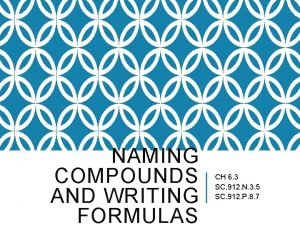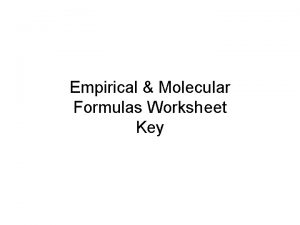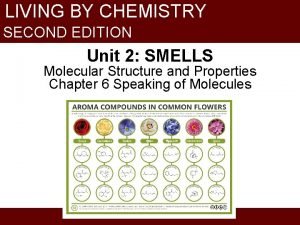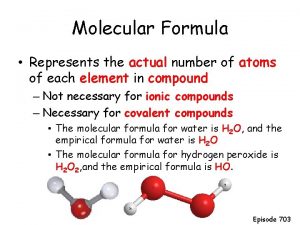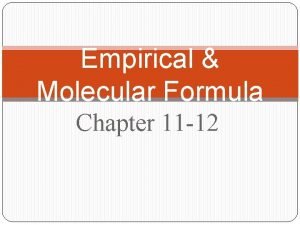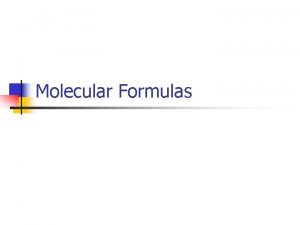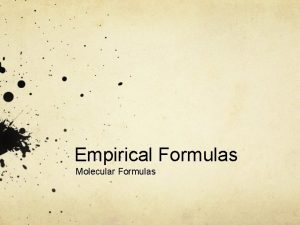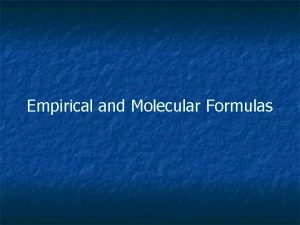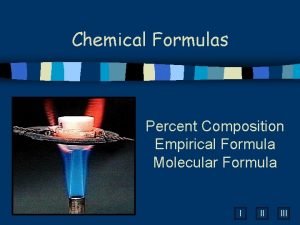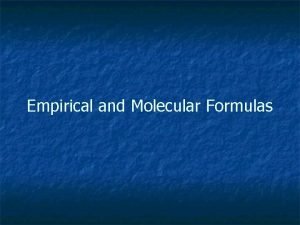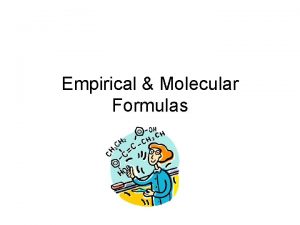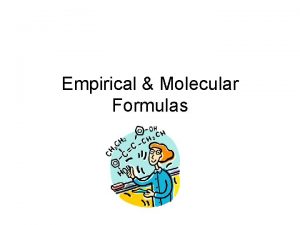7 3 NOTES Molecular Formulas E Molecular formula









- Slides: 9

7. 3 – NOTES Molecular Formulas

• E. Molecular formula • Since more than 1 compound could have the same empirical formula, in order to determine the molecular formula we need more information, such as the molar mass. • Molecular formula: the actual whole number ratio of atoms • For example, benzene has the molecular formula C 6 H 6, but the empirical formula is CH.


• The process is the same as empirical formula with one additional step. • Divide the molar mass given by the mass of the empirical formula. • Multiply this factor by the numbers in the empirical formula.

• Examples: • 1. 82. 7% of a compound is carbon and 17. 3% is hydrogen. If the molar mass is 58. 12 g, what is the molecular formula? • • C – 82. 7 g (1 mol/ 12. 0 g) = 6. 8916 / 6. 8916 = 1 x 2 = 2 • • H – 17. 3 g (1 mol/ 1. 01 g) = 17. 128/6. 8916 = 2. 5 x 2 = 5 • • C 2 H 5 = mass of 29. 1 • • 58. 12/ 29. 1 = 2 C 2 H 5 x 2 = C 4 H 10 •

• 2. Caffeine has the composition: 49. 5% carbon, 5. 19% hydrogen, 28. 9% nitrogen and 16. 5% oxygen. If the molar mass of caffeine is 194 g, what is the molecular formula? • • C – 49. 5 g (1 mol/ 12. 0 g) = 4. 125/ 1. 0312 = 4 • • H – 5. 19 g (1 mol/ 1. 01 g) = 5. 1386/ 1. 0312 = 5 • • N – 28. 9 g (1 mol/ 14. 0 g) = 2. 0642/ 1. 0312 = 2 • • O – 16. 5 g (1 mol/ 16. 0 g) = 1. 0312 / 1. 0312 = 1 • • C 4 H 5 N 2 O = 97. 1 • • 194/ 97. 1 = 2 C 4 H 5 N 2 O x 2 = C 8 H 10 N 4 O 2



 Naming and writing formulas for molecular compounds
Naming and writing formulas for molecular compounds Empirical and molecular formula worksheet doc
Empirical and molecular formula worksheet doc Find the empirical/simplest formula fe
Find the empirical/simplest formula fe Lesson 28: sniffing around molecular formulas answer key
Lesson 28: sniffing around molecular formulas answer key Significance of a chemical formula
Significance of a chemical formula Empirical formula of haemoglobin
Empirical formula of haemoglobin How to get empirical formula from percentages
How to get empirical formula from percentages Empirical formula
Empirical formula Empirical formula vs
Empirical formula vs What is meant by empirical formula
What is meant by empirical formula
